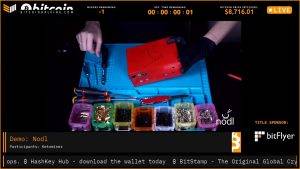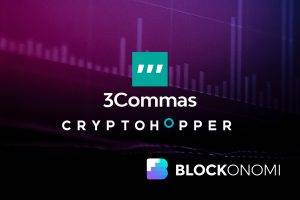A quick overview of the top providers of cross-chain (omni) liquidity is presented below:
- StakeStone: StakeStone’s LiquidityPad eliminates cross-chain friction and enables Ethereum-native capital to easily explore high-yield possibilities in a variety of ecosystems without subjecting users to complicated cross-chain procedures or bridge risks.
- Thorchain: This cryptocurrency eliminates middlemen and allows users to move money between blockchains without relying on a centralized exchange.
- Synapse Protocol: Think of it as a universal blockchain translator that allows both parties to communicate and exchange things from non-EVM streets to Ethereum’s neighborhood. Unlike native solutions, Synapse bridges the gaps to help individuals move their digital currency around and make the decentralized world smaller.
- SushiSwap (via SushiXSwap): To improve interoperability, SushiSwap is merging with Omni’s Open Liquidity Network (OLN). In order to combat liquidity fragmentation and safeguard asset sovereignty from bridges, the OLN promotes the use of open standards such as xERC-20, which provide native access to tokens across all EVM chains.
- LayerZero: The omnichain interoperability protocol, LayerZero facilitates asset transfers and communication between several blockchains.
LayerZero uses Ultra Light Nodes (ULNs), which are lightweight smart contracts that run on several blockchains to validate cross-chain messages without the need for bulky, resource-intensive nodes.
Introduction
Liquidity in finance is essential, unnoticeable, and only evident when absent. It is comparable to oxygen. Similar to how a busy marketplace benefits from the continuous flow of commodities, a liquid exchange needs continuous trading activity to stay open. Even the most promising decentralized exchange (DEX) or cryptocurrency network turns into a ghost town when liquidity evaporates, with price fluctuations, empty order books, and irate users.
Consider the 2008 financial crisis. Due to their reluctance to lend, banks—the so-called pillars of stability—choked the global financial system. The same idea holds in the cryptocurrency market: liquidity providers are the trustworthy go-betweens who guarantee that crypto assets may move quickly and predictably between parties, preserving market stability even in challenging market conditions.
High liquidity is not only a technical necessity for cryptocurrency exchanges, digital asset platforms, or token-focused initiatives but also a trading feature and a competitive advantage. Deeply liquid projects draw in more traders, produce steady market value, and eventually build confidence. Conversely, insufficient liquidity causes slippage, raises volatility, and makes trading cryptocurrencies a miserable experience.
To grasp its significance, let’s use an example from art. Let’s say you have a unique painting. It may have a $1 million theoretical market value, but that amount is meaningless if no one is prepared to purchase it. Similarly, in cryptocurrency trading, assets with high trading volume and deep liquidity allow transactions to happen quickly and with minimal impact from market conditions.

Cross-chain Liquidity between Blockchain Networks
Why Liquidity Matters in the Cryptocurrency Market
1.Price Stability: Big orders have little effect on the price in exchanges with high liquidity. On the other hand, even little trades can result in wildly fluctuating prices in situations with low liquidity. Strong liquidity on a cryptocurrency exchange platform guarantees more seamless transactions and steady market value.
2.Less Slippage: Traders see minimal slippage when making big trades on liquid exchanges. On the other hand, low-liquidity platforms frequently see differences between expected and actual execution prices, which can undermine user confidence and the profitability of cryptocurrency trading.
3.Market Credibility: Traders, institutional investors, and retail participants prefer the top cryptocurrency exchanges with lots of liquidity. The assurance that assets can be bought or sold quickly is fostered by stable liquidity.
4.Attracting Institutional Players: Low slippage, strong liquidity, and market stability are necessary for institutional adoption. Major institutional companies seeking to enter or grow inside the Bitcoin industry are drawn to platforms with substantial trading volume and liquidity.
5.Trading Features Optimization: Liquidity is a key component of advanced trading features like margin tools, OTC trading, and spot trading. Consistent liquidity provisioning is necessary for platforms that provide these products to continue operating.

Practical Checklist for Selecting a Liquidity Provider
- Good track record and reputation in the market
- Pools of deep liquidity for key trading pairs
- Competitive and transparent fee schedule
- Support for relevant trading pairs and assets
- Reliable API and integration tools
- Compliance with local and global regulations
- Transparent security practices
- 24/7 customer support
- Ability to scale with your business growth
Making the Right Choice
The ideal cryptocurrency liquidity provider is not a one-size-fits-all choice. A platform with a retail focus might place more emphasis on trading pair diversification, while an institutional trading desk might concentrate on reducing slippage for orders with significant value. The secret is to match your platform’s objectives with the provider’s capabilities.
Top Crypto Liquidity Providers List
The reputation, track record, and integration skills of crypto liquidity providers are essential considerations. Some of the most reputable names in the market are included in the list of cryptocurrency liquidity providers we’ve outlined below. These platforms have a strong track record of performance, extensive liquidity pools, and a strong infrastructure.
- StakeStone
StakeStone’s primary goal as an omnichannel liquidity infrastructure provider has always been to connect developing blockchain ecosystems with Ethereum’s robust liquidity. However, blockchain networks’ liquidity requirements are also changing as they specialize in particular use cases. StakeStone’s LiquidityPad offers a customized liquidity solution to meet liquidity provision’s increasing diversity and complexity. This solution helps ecosystems acquire the liquidity that best fits their growth goals.
LiquidityPad from StakeStone is an essential framework that connects new, specialized blockchains that have a high liquidity need to Ethereum, a resource hub with abundant liquidity. LiquidityPad unlocked a new paradigm of interconnected blockchain economies where capital can freely flow to its most productive use cases while maintaining strong security guarantees. It sets itself as the crucial pipeline for effective liquidity distribution across the omnichannel landscape by tackling the difficulties of cross-chain liquidity distribution and establishing a bilateral liquidity flow.
- THORChain
Transferring Bitcoin from the original Ethereum network or vice versa could be challenging. The purpose of THORChain is to overcome these obstacles. The most popular liquidity protocol for native cross-chain swaps is THORChain (RUNE).
THORChain links blockchains, including Litecoin, Dogecoin, Bitcoin Cash, Ethereum, BNB Chain, Avalanche, and Cosmos HUB. Cosmos Hub serves as the foundation for the THORChain blockchain network, as it does for many other solutions that emphasize interoperability. THORChain is a cross-chain solution, not a bridge in the traditional sense. Instead of moving assets between networks, you convert one network’s cryptocurrency to another’s coin or token.

- Synapse Protocol
Synapse Protocol is causing a stir on the blockchain technology frontier. Consider it a universal translator for blockchains, enabling communication and goods to be shared between them from non-EVM streets to Ethereum’s neighborhood. The secret ingredient enables seamless sharing and connection between these virtual islands. There is a strong call for better cross-chain ties due to the proliferation of the new Layer 1 blockchains. To assist people in moving their digital currency around and making the decentralized world a smaller place, Synapse fills in the gaps left by native solutions.
The Synapse SDK’s features
The Synapse SDK is a developer’s equivalent of a Swiss Army knife. Thanks to it, developers can easily send messages between multiple blockchains and execute cross-chain contract calls. The Synapse SDK allows developers to have complete control over user interactions across chains.
Here is a brief overview of the features available in the Synapse SDK:
- Smart contracts on one blockchain can communicate with those on another through cross-chain contract calls, adding extra capability.
- Developers may send personalized messages across blockchains with Arbitrary Cross-Chain Messaging, which is ideal for various applications.
- Developers can customize how consumers interact with apps when traversing chains.
- Facilitates asset transfers and communication across various blockchain configurations with support for EVM and non-EVM networks.
- SushiSwap (via SushiXSwap)
With over 3 chains using it, SushiSwap is a top DEX in the EVM ecosystem. The Open Liquidity Network will be a significant step toward improved interoperability between Sushi on each chain and all of the apps it communicates with. Omni’s Open Liquidity Network (OLN) promotes open standards such as xERC-20. Thanks to standards like these, all EVM chains can natively access tokens. This addresses liquidity fragmentation and safeguards asset sovereignty against bridges. Omni creates the most seamless interoperability solution by fusing these standards with its cutting-edge communication layer. Since liquidity is harmonized across all major roll ups thanks to open protocols like xERC-20, users can quickly access their $SUSHI without needing bridged tokens. The user experience is significantly enhanced by Omni’s communications layer, which helps to abstract the token relocation process. Additionally, Omni uses Ethereum restaking, which gives consumers the security of Ethereum combined with roll-up speed.
- LayerZero
LayerZero, addresses interoperability through a standard messaging protocol, facilitating smooth asset transfers between blockchain networks and is supported by industry leaders such as a16z and Sequoia. Tokens like yBTC, which is Bitcoin’s highest-yield, lowest-risk liquid staking token, may function across LayerZero’s supported chains without the usual bridging restrictions thanks to the Omnichain Fungible Token (OFT) standard, which has a cross-chain volume of over $5 billion. This innovation opens the door for a fully linked blockchain future by providing users across ecosystems with safe, effective, and high-yield prospects. LayerZero has demonstrated its strong cross-chain architecture by supporting over 70 blockchain networks and facilitating more than $50 billion in asset transactions. Thanks to LayerZero’s efficient and safe interoperability between these networks, users and developers can easily engage with many blockchains, including well-known networks like Ethereum, Polygon, and Solana. This is made possible by its Ultra Light Nodes (ULNs) and decentralized oracles.
Conclusion
With several trends and advancements slated to improve market depth, efficiency, and stability, the future of cryptocurrency liquidity seems bright. Key factors influencing the future of crypto liquidity include growing institutional engagement, DeFi’s expansion, technological developments, regulatory changes, and the integration of conventional financial institutions. Even so, resolving these problems will open the door to a more stable and liquid cryptocurrency market by 2025.
References
Crypto Liquidity Providers List and How to Choose the Best
LayerZero: Is this the Future of Cross-Chain Communication?
$SUSHI Integrates with The Open Liquidity Network
Synapse – The Most Widely Used Cross-chain Bridge
THORChain (RUNE) is the leading liquidity protocol for native cross-chain swaps









